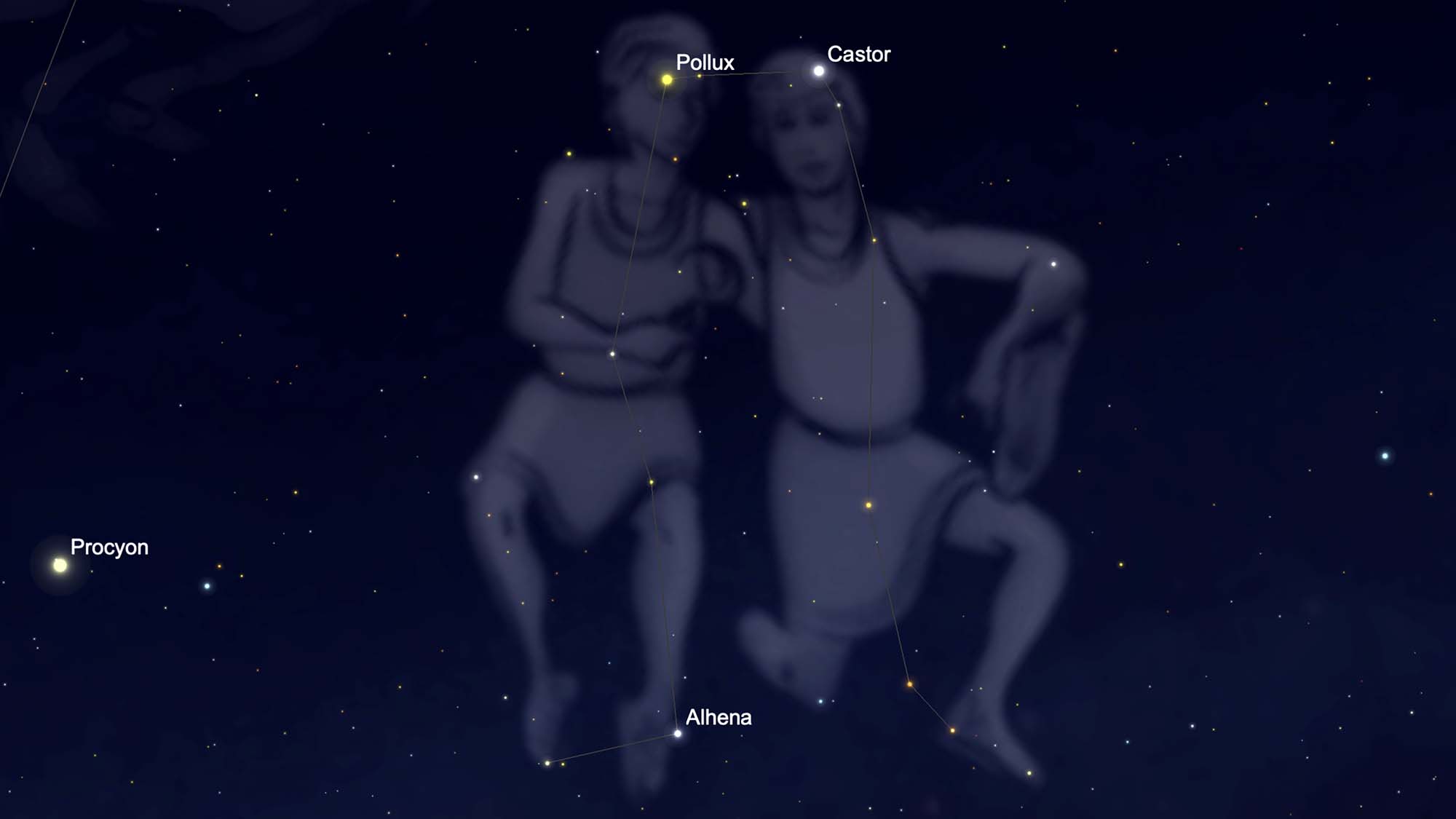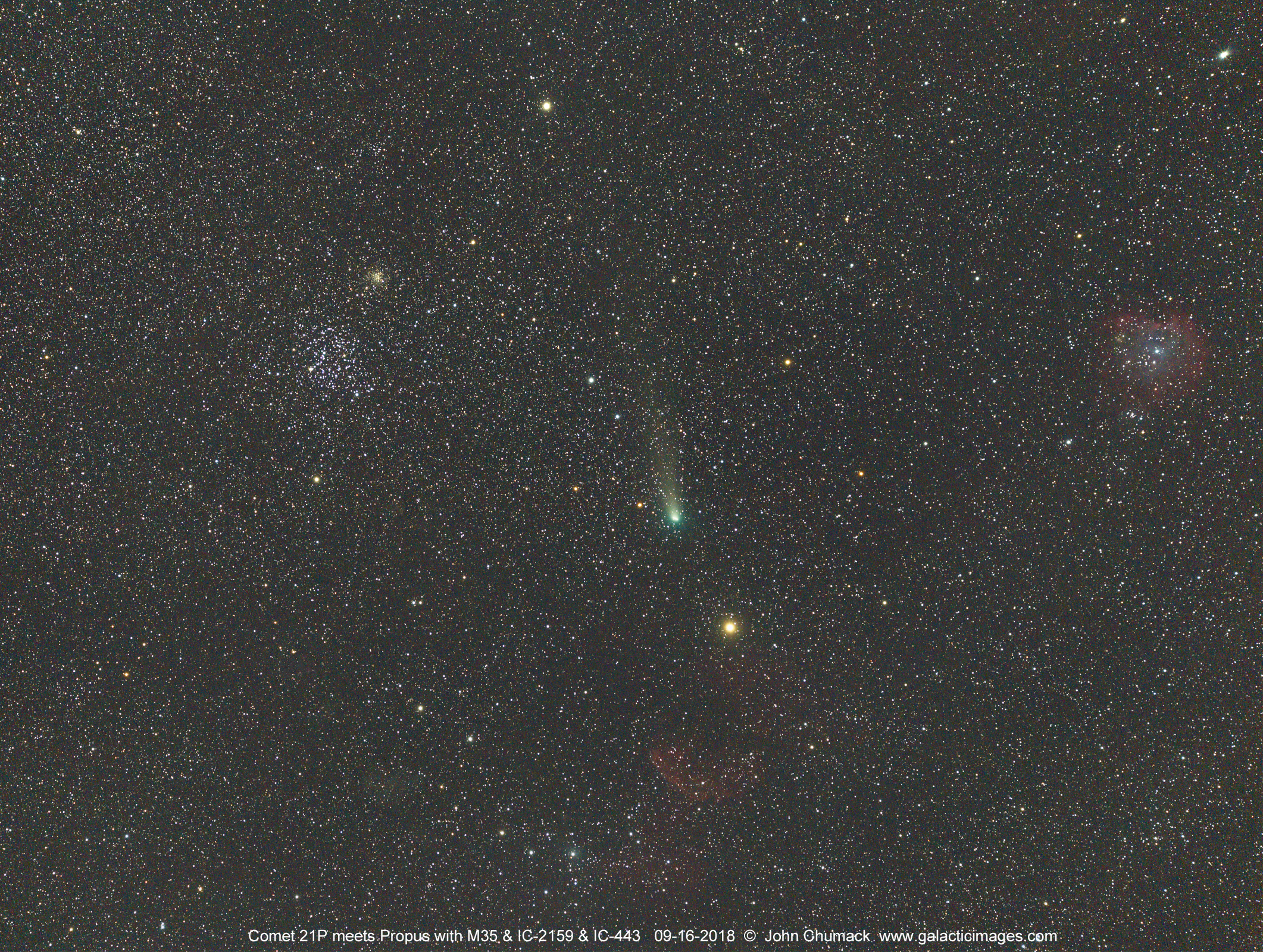
Although spring has officially been with us now for just over a week, we can still partake of many of the bright stars of the wintertime season. At around 9 p.m. local time, over toward the west and south our early evening sky is still strewn with brilliant constellations and outstanding deep-sky objects.
Interestingly two of these star patterns, mighty Orion, the hunter and Gemini, the twins rise together. Both are oblong in shape, though Gemini is somewhat longer and thinner; it contains far fewer bright stars compared to neighboring Orion, and Gemini does not contain a distinctive line of stars in the middle to match Orion's three-star belt. Both figures are tilted as they ascend in the eastern sky, elevated at the ends toward the Milky Way that lies between them.
Gemini is positioned farther to the north than most of the other winter constellations and seems to drop behind the rest as they climb high into the sky, passing more or less overhead when at their highest, bringing up the rear of the westward march across the sky along with Orion's two dogs. In fact, even though they are generally considered to be a wintertime star pattern, we might consider Gemini to belong more to early spring.
Related: Constellations of the night sky: famous star patterns explained (images)
There they are, standing upright, high up in the western evening sky: the Gemini twins.
The heads of the twins are the bright stars Pollux (yellowish; 17th-brightest star in the sky) and Castor (white; a bit dimmer than Pollux). Castor is famous in the annals of binary stars as the pair whose mutual revolution was first made known. It was the British astronomer William Herschel who provided in the year 1803 that the two stars of Castor are united by the bond of their attraction. And in fact, Castor is actually a system of six stars, forming one of the most remarkable examples of a multiple-star system in the heavens. With the naked eye we see only one star, but just imagine, in that one speck of light we actually have six stars for the price of one! This sextuple star can be seen only as a double through a small telescope.
Yellowish Pollux, too, has a companion — though not a star, but a planet. It was discovered in June 2006 and was originally known as "Pollux b," but is now called Thestias. It's a gas giant about twice as large as Jupiter and orbits Pollux at a distance of 1.65 astronomical units — a little farther from its star than Mars is from the sun.
Get the Space.com Newsletter
Breaking space news, the latest updates on rocket launches, skywatching events and more!
The stars that compose the twins' arms and bodies are fainter than those in their heads and feet. A second-magnitude star known as Alhena marks one of Pollux's feet. In places where light pollution hides many of the fainter stars, only Pollux, Castor and Alhena may be visible, forming a long wedge with its point aimed straight at Orion.
According to legend, Pollux and Castor hatched from an egg from their mother Leda, following her seduction by Zeus. The twins were among the heroes who sailed with Jason in the quest for the Golden Fleece. They helped save the great ship Argo from sinking during a major storm, and for this reason ancient mariners regarded Pollux and Castor as the patrons of seafarers. In Elizabethan times they were also considered the protectors of all at sea. The expression "by Jiminy" was a popular corruption of the swearing by the ancients by these patrons, as in "by Gemini." The brothers have figured in scores of ancient folk tales. They were adventurers, warriors, and famous navigators.
A new planet!
If I were to venture a guess, I would think that Gemini was William Herschel's favorite constellation. Not only did he make the discovery revealing Castor to be a binary star, but this musician (an organist), who made telescopes for diversion and spent much of his spare time observing the heavens, discovered a new planet in Gemini.
Herschel was observing stars in Gemini on the night of March 13, 1781, when he ran across a star that "appeared visibly larger than the rest ... I suspected it to be a comet," he wrote in his notes. By the end of August, with Gemini rising in the morning sky, the new object was visible once more. But the more astronomers studied it, the more they began to wonder if it really was a comet. For one thing, it seemed to be following a nearly circular orbit out beyond Saturn, whereas comets have highly elliptical orbits that carry them far away into the outskirts of the solar system in between each close pass by the sun.
It was Finnish mathematician Anders Lexell (1740-1784) who first confirmed that Herschel had found a new planet in the solar system; another wanderer barely visible to the naked eye and twice as remote from the sun compared to Saturn. It was the first planet to be discovered with a telescope. Following this discovery, which won him international acclaim, Herschel accepted an offer from King George III to give up his music career and to become Sir William Herschel, England's Astronomer Royal.
Many people thought that the planet should be named Herschel as an additional honor to its discoverer. Herschel himself named it Georgium Sidus, or "George's Star," after the King. But astronomers ultimately decided to call it Uranus to match the classical names of the other planets. Certainly, that made more sense, otherwise our list of the planets going outbound from the sun would read this way: Mercury, Venus, Earth, Mars, Jupiter, Saturn and ... George?
One of the "greatest sights"
Located just off the trailing foot of Castor, is the 35th deep-sky object that was cataloged by French astronomer, Charles Messier (1730-1817). Called Messier 35 (M35), it can just be seen with the unaided eye on dark transparent nights. In low-power binoculars it may look like a dim, fairly large unresolved interstellar cloud, but look again. Even through light-polluted suburban skies, glasses with 7X magnification reveal at least a half dozen of the cluster's brightest stars against the whitish glow of about 200 fainter ones.
M35 has been described as a "splendid specimen" whose stars appear in curving rows, reminding one of the bursting of a skyrocket. Walter Scott Houston (1912-1993) who wrote the Deep-Sky Wonders column in Sky & Telescope magazine for nearly half a century called M35: "one of the greatest objects in the heavens; a superb object that appears as big as the Moon and fills the eyepiece with a glitter of bright stars from center to edge."

Comet masquerader
Located less than half a degree southwest from M35 is an unusual object that brought me a brief surge of excitement, as well as to countless numbers of other amateurs over the years. In September 1985, while camping in the Adirondacks of northern New York, I was scanning the Orion-Gemini region with my 10.1" Dobsonian telescope, looking for two famous periodic comets, Halley and Giacobini-Zinner. It was then that I stumbled across a faint, circular cloud of light, which initially appeared as a possible new comet.
The object, in fact, is the faint open star cluster NGC 2158. Indeed, if you get a chance to train a telescope on M35 and come across this small, faint patch of nebulosity a short distance away at least you won't be making the "comet mistake" that so many others have made. On that September night back in 1985, for not a few minutes I thought I was looking at "Rao's Comet" but after composing myself and checking a celestial handbook, I came back down to Earth. "Scotty" Houston himself fell into this trap, later calling NGC 2158 his "lasting monument to my early, somewhat careless, years of observing."
- Constellation quiz: What's your cosmic IQ?
- Stargazer spies star clusters of the Gemini constellation (photo)
- Newfound Comet ATLAS is getting really bright, really fast
Joe Rao serves as an instructor and guest lecturer at New York's Hayden Planetarium. He writes about astronomy for Natural History magazine, the Farmers' Almanac and other publications. Follow us on Twitter @Spacedotcom and on Facebook
OFFER: Save at least 56% with our latest magazine deal!
All About Space magazine takes you on an awe-inspiring journey through our solar system and beyond, from the amazing technology and spacecraft that enables humanity to venture into orbit, to the complexities of space science.
Join our Space Forums to keep talking space on the latest missions, night sky and more! And if you have a news tip, correction or comment, let us know at: community@space.com.

Joe Rao is Space.com's skywatching columnist, as well as a veteran meteorologist and eclipse chaser who also serves as an instructor and guest lecturer at New York's Hayden Planetarium. He writes about astronomy for Natural History magazine, Sky & Telescope and other publications. Joe is an 8-time Emmy-nominated meteorologist who served the Putnam Valley region of New York for over 21 years. You can find him on Twitter and YouTube tracking lunar and solar eclipses, meteor showers and more. To find out Joe's latest project, visit him on Twitter.










